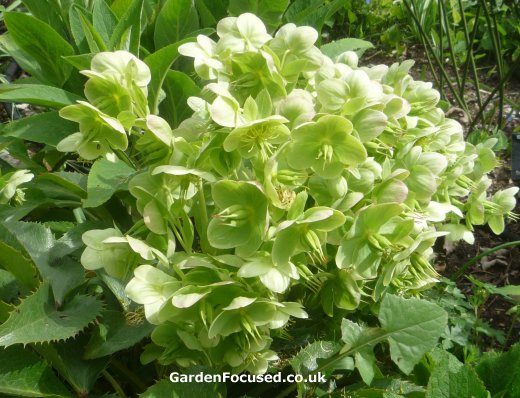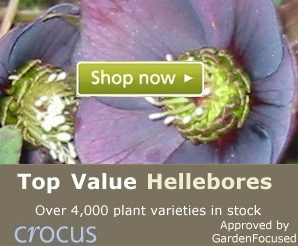BEST VARIETIES OF HELLEBORES
Article by David Marks
Selecting the best hellebore variety for your garden has become extremely complicated in the last few years because plant breeders have produced an amazing array of new flower colours, forms and even the time of flowering.
This guide is for the amateur gardener and not the botanists. We select commonly available hellebores in the UK which we believe offer value for money, reliability and beauty.
First a quick overview of the main Hellebore species which are the backbone of the hybrids now available.
HELLEBORUS ORIENTALIS
Originally found mainly in Greece, Northern Turkey, Georgia and southern Russia. This is the original Lenten Rose and although normally producing white, cream or light green flowers it does have other colour variations. Although used extensively in the breeding of other species it has now been surpassed by others in reliability and flower production.
The flowers are roughly 7cm / 3in wide and have no scent. When the flowers first open they tend to point downwards making them difficult appreciate in winter on a plant which is normally only 45cm / 18in high. Orientalis is an evergreen perennial which lives for 20 years or so and is fully hardy in all areas of the UK.
HELLEBORUS NIGER
This is the original Christmas Rose which unfortunately rarely flowers at Christmas! It tends to start flowering in late January in the UK.
This species only manages an average height of up to 30cm / 12in and produces attractive white / cream flowers which are about 5cm / 2in wide. The flowers tend to open so they can be seen from above but are easily damaged and flattened by rain, snow and wind.
We don’t recommend them nowadays. Even though “nursery fresh” ones may look good, as do those grown under cover, they are too fragile for the average garden.
Recent breeding of Helleborus Niger however has produced specific series which not only flower at Christmas but even produce double flowers. They also produce more flowers and are stronger growing plants which last for many years.
CORSICAN HELLEBORE
The full name is helleborus argutifolius. Native only to Corsica and Sardinia, we recommend it highly. It will grow to over a meter tall and wide this is a strong growing and healthy plant. Although the pale green flowers may not sound colourful, they truly do add interest to any flower bed. The RHS have given this variety their Award of Garden Merit.

![]()
Corsican Hellebore
Th leaves are serated and attractive all year round. The light green flowers appear in January and last until March or April. The picture above was taken in the middle of April and the flowers still look fresh. Unlike many other hellebores you can see the full flower even when looking down at the plant from a standing height.
They are widely available online, we would recommend Crocus as a supplier – they list it as the official name “helleborus argutifolius”.
HELLEBORUS FOETIDUS
Also know as the “stinking hellebore” because of its unattractive scent of the leaves if they are crushed. This is one of the few non-hybrids which has retained the RHS Award of Garden Merit although we doubt this will remain in a few years time.
They are evergreen, growing to about 60cm / 2ft high and wide. The flowers are a light green, sometimes with a small purple edge to them. The provide architectural interest rather than splashes of colour. There are a few varieties such as “Miss Jekyll” with slightly scented flowers and the “Wester Flisk Group” with brighter leaves.
HELLEBORUS HYBRIDUS
This is the species which will suit most gardeners better than the others. As the name suggests these are hybrids of the original species and have been bred to grow well in most garden situations. Botanists gave up classifying several species many years ago and now simply group them under the name Helleborus Hybridus.
There are so many varieties available that it would require a book to name and describe each of them so how best to choose one or two which will suit your needs?
First, choose your plant supplier wisely! Especially with hellebores, your main guarantee of getting the plant you hope you are buying, rests with the supplier. Without a doubt don’t by them from the discount stores nor from online general purpose websites such as Ebay.
If you do, the risk of being disappointed is higher than with most other plants. Our personal recommendation is to stick with one of the larger online suppliers such as Crocus, Thompson & Morgan, RHS etc. Remember also, when comparing prices to take into account how large the plant is.
Size is important, with the difference between a 9cm plug plant and one in a 2 litre pot being very significant. The larger plant will not only come into flower quicker but will require far less attention during the first season.
When a hellebore is grown from seed the colours will vary however some vary more than others. Much depends on how the plants have been bred. This is where cost comes in. In general, those plants which are more likely to come true to type are more expensive.
One method of selecting a hybrid hellebore is to choose from one of the popular series. Each series contains a large number of plants but they tend to share some basic characteristics. We describe some of the popular hellebore series available in the UK below.
HARVINGTON SERIES
Harvington is a mile or so north of Evesham in Worcestershire. It is also the home town of Hugh and Elizabeth Nunn who have bred the Harvington series of hellebores. Their nursery in Evesham has now closed down but the breeding program has been passed down to their daughter, Penny Dawson.
This series stands out because they are propagated from seed. Nothing unusual about that except that hellebores are notoriously difficult to come true to parent type when grown from seed.
The Harvington series however do come true to type, and this has been achieved only after decades of experience. This is one reason why the prices of this series are slightly higher compared to some others but you get what pay for with a Harvington.
The second benefit of Harvington hellebores is that (because they are raised from seed) they can be grown in large, polytunnels rather than under climate controlled glass. This ensures that when you buy one they are acclimatised to real, local conditions rather than highly controlled glasshouse conditions.
You end up with a very healthy plant which will not be shocked by the transfer to garden conditions. The colours and size of the flowers is exceptional and the foliage is a healthy and glossy green. This series has out top recommendation for the average, amateur gardener.
They come in a range of colours and sizes, our favourite is a relatively new variety called “Harvington Double Chocolate”. The petals are thinner tan average but there are lots of them, an excellent choice. For more Harvington varieties in a wide range of colours and forms, click here.
RODNEY DAVEY MARBLED GROUP
If you are new to hellebores this is the one we would recommend you buy first. Although classified as a series, there is one variety that stands out as superb, Anna’s Red. The flowers are a deep red-purple, larger than average and stand well clear of the foliage. Superb!
The foliage itself is unusual being a mottled and veined green and it has taken Rodney Davey many years to perfect this variety. The plants sold are micro-propagated and this guarantees that each is exactly the same. Something which is impossible from seed. See more about the variety Anna’s Red here.
ASHWOOD SERIES
Ashwood Nurseries in Ashwood, Staffordshire is a few miles west of Birmingham. They have their own breeding program which not only includes the hybrid hellebores, it also includes other species.
LADY SERIES
The Lady Series of hellebores was bred by Gisela Schmeimann in Germany. This series tends to produce blooms which are a single colour although variations within that colour will occur. If you want a mass of hellebores all of a very similar colour and at a reasonable price.
